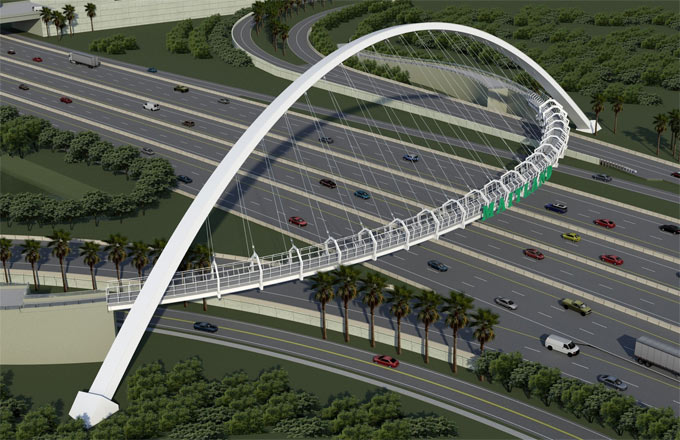
How to use Staad Pro for making analysis and design of Pedestrian Bridge Using Staad Pro
Different types of foot bridges are found on the basis of structural configuration and materials. Recently, steels are extensively used to construct modern footbridge with a focus on sustainability and eco- friendliness.
In this construction article, you will get to know how a simple pedestrian bridge is modeled with Staad Pro software as well as the result of internal stresses because of crowd load on the bridge.
Actions on Bridges: The action on footbridges is clearly provided in section 5 of EN 1991-2. The load models illustrated in the code and their representative values (which contain dynamic amplification effects), are utilized for ultimate and serviceability limit state static calculations. However, adhoc studies are necessary while making vibration estimation on the basis of specific dynamic analysis.
There exist three mutually exclusive envisaged vertical load models for footbridges (5.3.1(2) EN 1991-2:2003);
(1) A uniformly distributed load illustrating static effect of a dense crowd, (2) One concentrated load illustrating the impact of maintenance load, (3) One or more, mutually exclusive standard vehicles should be considered if maintenance or emergency vehicles are supposed to cross the footbridge itself.
The impact of crowd action on a footbridge is demonstrated with a uniformly distributed load that is based on the loaded length of the footbridge. However, when a road bridge is providing support to a footway, a UDL value of 5.0 kN/m2 is suggested by the code for that section. This value is equivalent with continuous dense crowd action that is represented as Load Model 4 of road bridges.
However, when such risk of dense crowd action does not exist, the load on the pedestrian bridge is provided as follow :-
qfk = 2.5 kN/m2 = 120/(L + 30) = 5.0 kN/m2
For the assessment of local, a concentrated load of 10 kN is supposed to operate on a square surface of sides 0.1 m. This load should not be incorporated with other variable non-traffic load.
For horizontal forces, a horizontal force functions all together with the equivalent vertical load whose characteristic value is identical with 10% of the total load relative to the uniformly distributed load. This horizontal force does not associate with the concentrated load, and operates along the bridge deck axis at the pavement level on square surface of sides 0.1 m. This force is normally adequate to retain the horizontal longitudinal strength of the bridge.
However, there exist non-traffic actions operating on footbridges like thermal action, wind action, snow action, indirect actions ranging from support settlement, etc. It is also vital to take into account accidental actions on the bridge specially vehicle collision on the substructure of the bridge.
For stiff piers, EN 1991-2:2003 suggests a minimum force of 1000 in the direction of vehicle travel or 500 kN in the perpendicular direction. These collision forces are intended to operate at 1.25 m over the level of the ground surface.
N/B: Vehicle collision on the piers is more common on footbridges as compared to highway bridges. So, it is suggested that the piers of the footbridge should be defended with any valid and effective approach. Road restraint system is set at a distance from the piers. The deck should be high enough to resist collision also.
To get more detail information, go through the following link www.structville.com


